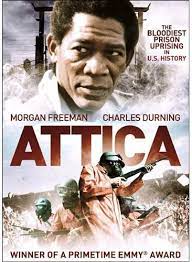
ATTICA
US, 2022, 117 minutes, Colour.
Directed by Stanley Nelson.
At the time, and in retrospect, the prisoner revolt in Attica, the prison, from the 1930s, in the north of New York state, and the military and police putting down of the revolt, was a shocking event.
There have been a number of films about Attica over the decades, a documentary in 1974 enabling audiences in America and around the world to see something of what actually happened. Later, there was a docudrama reconstruction in a telemovie starring Charles Durning. This documentary was made on the 50th anniversary of the siege in Attica.
The film is often distressing, harrowing in its portrayal of what happened, drawing extensively on film shot at the time, television footage, which immerses the contemporary audience in the experience of the prisoners, of the political response from the Commissioner of police, the non-intervention by Gov Nelson Rockefeller and his motivations, his contact with Pres Richard Nixon.
There is a range of talking heads, from prisoners at the time, reminiscing, frank memories, their perspective on what happened and who was involved. Among the talking heads is Sen John Dunne who is part of the observers committee, Clarence Jones (who had appeared in the 1974 documentary, African-American, part of the observer committee, John Johnson, prominent African-American journalist of the period. These last three, involved at the time, have the opportunity to reflect on the events are 50 years earlier, Clarence Jones noting at the end that never will he forget Attica, ever, ever, ever, ever, ever… Writer Tom Wicker is prominent in the footage material of the time, talking about the possibilities for mediation between authorities and inmates, and his bewilderment.
There are also interviews with relatives of some of the guards and hostages, the daughter of the guard, Quinn, who is overwhelmed, his keys taken which led to the opening up of gates and cells, who eventually died from his injuries. There are also interviews with relatives of some of the hostages, still emotional 50 years later.
And there are many scenes, outside the walls of Attica, the number of police ready outside to act, the final calling in of the National Guard, the range of relatives of the hostages also waiting – with the commentary that the guards came mainly from the surrounding towns, never having experienced black ghetto life in New York City, the prisoners, mainly black, seeming like aliens from another foreign world – and expressions of racist attitudes, hatred and revenge, the final image of a policeman raising a fist for quite power.
The structure of the documentary is to take the events day by day, the five days in September.
The inmates overcame a guard, taking his keys, opening gates, and a huge number of the prisoners experiencing some kind of freedom. While there was no one in charge, some characters emerged forcefully, especially young man, L.D.Berkeley, who became a vigorous spokesman for the further requests and proposals of the men. As listed, they were very basic, sanitary, meals, conditions, of which the Commissioner found 28 to be acceptable. The Commissioner himself came in and sat down with the men – but forgot that they could watch television and hear his rather different perspective in interviews outside the walls. Bobby Seale came for some short time but this did not seem to have much effect.
Negotiators came in. Acceptable journalists. Then a committee of 30 people who could be a committee of observers, discussions and negotiations.
However, when the guard, Quinn, died of his injuries, the situation changed. Police attitudes hardened – many ready to enter the prison and attack. Eventually, with the National Guard brought in, the attack began on the fifth day, the inmates having only iron pipes, baseball bats, sharpened sticks, no match for the military and police tactics and gas to subdue the crowds, and gardens.
The filming of the attack is alarming. However, audiences may be surprised to find the number of dead rather limited, 29 inmates, but 10 hostages – with immediate rumours that their throats were cut. However, the medical officer announces to the media that this is not the case – and, it emerged that the hostages were killed by the police, who because of their being dressed in prison clothes, assumed that they were prisoners attacking them rather than running to freedom.
The aftermath is also appalling, making the prisoners run across ground with broken glass, barefoot, hitting them if they did not run. Then they lined up naked, long lines of naked prisoners, humiliation by the police.
One of the National Guard of the time explains that his officer told them that they had seen excessive violent behaviour by the authorities but that they were not to speak of it because the public would not be ready for such truth.
In an aftermath, there is information that financial deals were done with New York State in 2000 and later with the surviving inmates as well as the relatives of the hostages.
In 2022, the film was selected for preservation in the National Film Registry by the Library of Congress as being "culturally, historically, or aesthetically significant".